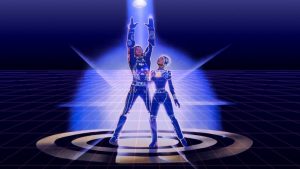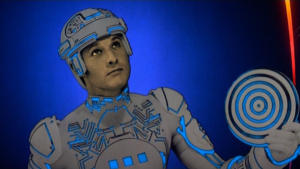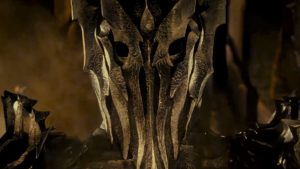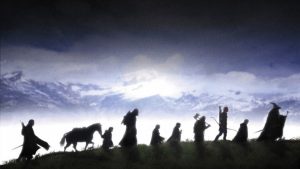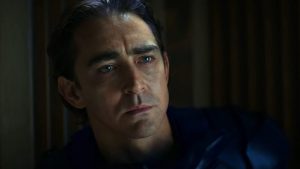Strange women lying in ponds distributing swords may be no basis for a system of government, but it is a pretty decent hook for a Netflix series. Cursed, the streaming service’s epic new Lady Of The Lake retelling, definitely mangles the Arthurian source material (and takes an extremely long time to get to the whole Lady Of The Lake bit), and even as a standalone it suffers from a number of problems, but it still tells a crafty little story about wizards, witches and Vikings (you heard me correctly), all wrapped up in the standard Netflix package.
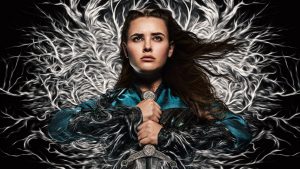
That standard package can sometimes be very standard (characters falling hopelessly in love with each other after approximately fifteen seconds! How original!), but the show does go through several highs and lows in terms of quality – with some of its highs being extraordinary (the entire climax to episode four) and some of its lows being abysmal (pretty much every attempt at heterosexual romance). The series takes a little while to get going: the first two episodes, unfortunately, are the weakest, as we follow our reluctant protagonist Nimue (Katherine Langford) on the first steps of her journey, but episode three is good and episode four is great. After that, the quality takes another dip, but the series regains its footing in time for the finale.
Our heroine Nimue begins her epic quest as a Fae villager living comfortably far away from the merciless brutality of the Catholic Church’s servants, the Red Paladins, whose mission it is to wipe out magic across England (it’s best to just accept that they live in England, despite the wonky geography and the constant references to a nearby “desert kingdom”). Nimue is soon entrusted with a powerful sword which grants her increased power, strength, and, as time goes on, an unceasing blood-lust. Langford’s performance as the cursed young woman is a strong one, though she clearly falters in romantic scenes when partnered with her love interest, the handsome young Arthur (Devon Terrell). That’s entirely fair – the romance is boring and conventional, and the dialogue meant to build chemistry and passion is unoriginal. Langford’s greatest strength is when she’s in the thick of battle, wielding Excalibur (sorry, the Sword Of Power) alongside her Fae magic.
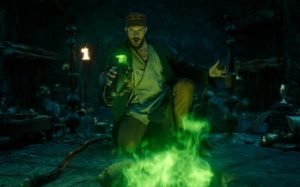
But the thing that makes Nimue’s arc most interesting is that she’s not technically supposed to be wielding the sword. In fact, the words “Take this to Merlin” echo through her head over and over again. The Merlin in question is none other than Merlin the Magician (Gustaf Skårsgard), the legendary sorcerer of Arthurian legend who is deeply entangled in all the myths surrounding the English king’s rise to power. Here, he is even more intimately entwined in Nimue’s story. Skårsgard does a good enough job conveying the ancient wizard’s inner turmoil and pain, but he brings significantly less fun to the role – and the character of Merlin, who in this version stumbles around drunk half the time and uses his wits to escape any number of situations, needs that quirky dash of humor. The lack of it is surprising, and makes Merlin far less engaging than he might have been.
The supporting cast surrounding these three main characters is vast and filled with highlights – Morgana (Shalom Brune-Franklin), a sorceress in the making, treads a fine line between good and evil while various demonic entities try to make her their pawn; Pim (Lily Newmark), is a cheery, wide-eyed Fae who makes the impulsive decision to join a pack of Vikings; Sister Iris (Emily Coates), a frighteningly intense young nun, is set up to be this show’s answer to Game Of Thrones‘ Arya Stark – only Iris is more like a mix between Little Red Riding Hood and The Terminator. And Peter Mullan fully transforms into the series’ villain, Father Carden, the friendly, smiling leader of the Red Paladins’ genocidal crusade. Carden’s Paladins make perfectly decent villains: but while they have no problems burning or crucifying innocents and pillaging the defenseless, they aren’t a well organized military force and thus their battles are often on the weak side. But that’s where the Vikings come in.
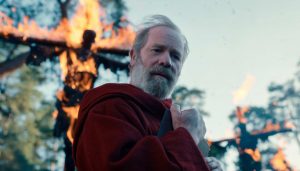
The Vikings are everywhere in this series. All the time we spend on the longships of The Red Spear (Bella Dayne) with Pim might seem pointless at first (though I stopped feeling that way once we were treated to a hilarious montage of Pim, who was enlisted as the crew’s healer, trying desperately to keep up with the raiders’ never ending brutal injuries), but it is integral to the events of the finale, which sees multiple Viking clans clash in epic warfare: and, based on the secret identity of one specific Viking character, it will prove to be integral to the events of future seasons of Cursed, if there are any. All that being said, it’s hard to stop from laughing when King Cumber (Jóhannes Haukur Jóhannesson) arrives about halfway through the season with a ridiculously mangy platinum blond wig that appears to have been loosely glued to the top of his head. If you thought Henry Cavill’s wig in The Witcher was bad, then you’re going to be horrified by Cursed, which has plenty such awkward hairpieces.
Besides occasionally looking awful, the hair, costumes and makeup utilized on this show don’t even try for any semblance of historical accuracy. For instance, the court of the distasteful Uther Pendragon (Sebastian Armesto) is a complete mix-and-match of styles, ranging from late Medieval to Victorian, with some background characters appearing to have stepped out of the 16th or 17th Centuries. I was tempted to say that Cursed is reminiscent of an Assassin’s Creed interpretation of history, but I actually think the video game series does a far better job of achieving authenticity – though the Trinity Guard, an elite sect of gold-masked Catholic warriors wielding maces and whips under the command of a solemn, vaguely reptilian abbot, feels like it would be very much at home in the game. As does The Weeping Monk (Daniel Sharman), a nimble assassin and another of the series’ roster of antagonists – but his journey takes some very interesting twists and could be relevant to the LGBTQ+ community in ways which I don’t wish to spoil here.
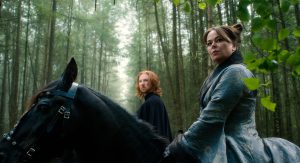
Cursed is well worth the long ride (and it’s a long ride indeed) for its strong lead performance, the beautiful aesthetic – insert shoutout to those absolutely lovely animated scene transitions here – the surprisingly good cinematography, and the political intrigue: one of my favorite fantasy tropes, very well executed here, with a particular emphasis on how powerful women often had to work their influence from behind the throne. Two wildly different women – the quiet, calculating Lady Lunete (Polly Walker) and the sadistic berserker Eydis (Sofia Oxenham) – both have to operate in this fashion.
The diversity is another good reason to settle in for the ten-episode ride: though some audiences will inevitably become enraged by the mere presence of people of color – and women of color, especially – in 4th or 5th Century England, I think that’s a stupid complaint because people of color have been living in England since Roman times, well before Arthur’s reign. If anything, that’s one of the few things that Cursed actually gets right when it comes to historical accuracy. Maybe instead of getting offended by black people and LGBTQ+ characters, you should direct your attention toward the swarms of Vikings coming down from Norway about two hundred years early? Just a thought.
If you’re at all interested in fantasy, you’re at least going to have a fun time with Cursed. It’s shamelessly entertaining when it wants to be (i.e. when it doesn’t get bogged down in love triangle tropes), and there’s nothing wrong with just watching something because it’s fun, and has some thrills and scares and big cliffhangers. If you’re hoping it’s the next Witcher, I’d encourage you to lower your expectations just a little bit – just a little bit, mind you. It’s not so far behind its more high-profile Netflix competitor in terms of quality that it could never catch up in future seasons (and I’m going to hazard a guess based on the finale that future seasons are planned because otherwise I’m suing Netflix), but it still needs to find its own voice amongst the crowd.
Series Rating: 6.5/10
